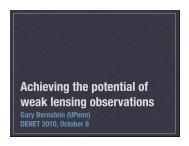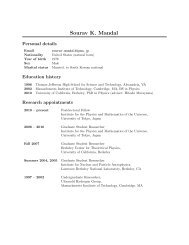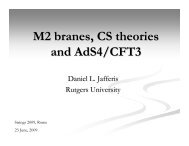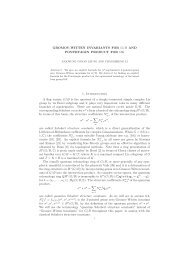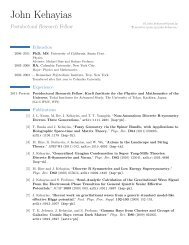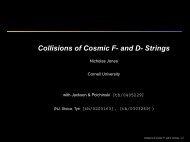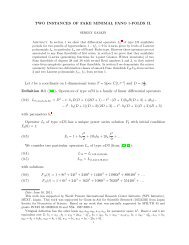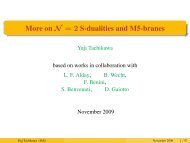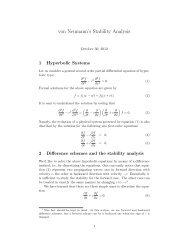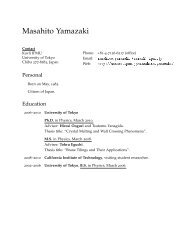STUDY SUMMARY - IPMU
STUDY SUMMARY - IPMU
STUDY SUMMARY - IPMU
You also want an ePaper? Increase the reach of your titles
YUMPU automatically turns print PDFs into web optimized ePapers that Google loves.
<strong>SUMMARY</strong> REPORT<br />
WIDE FIELD FIBER-FED OPTICAL<br />
MULTI-OBJECT SPECTROMETER (WFMOS)<br />
ID<br />
1<br />
2<br />
3<br />
4<br />
5<br />
6<br />
7<br />
Table 7.4-1: Summary of Risk Assessment and Management<br />
Item<br />
Custom detectors don't meet<br />
performance requirement<br />
schedule risk on the spectrograph<br />
gratings<br />
The square wave drive approach<br />
does not adequately drive the<br />
positioner motors.<br />
Positioner resolution too high or<br />
velocity versus position and/or step<br />
size too erratic.<br />
Telescope environment not as<br />
expected and affects instrument<br />
performance<br />
Positioner contractor unable to<br />
perform<br />
Spectrograph Aspherics difficult to<br />
manufacture<br />
2 4<br />
3 2<br />
2 3<br />
2 2<br />
2 2<br />
1 2<br />
1 2<br />
Likelihood<br />
Consequence<br />
Mitigation<br />
Change to a 6k×4k format from Hamamatsu with<br />
15µm pixels<br />
Start testing w/ one grating or early low-spec grating.<br />
Consider Kaiser Optics as a second supplier<br />
Work w/ NST to modify motor design. Return to the<br />
sine wave drive and switching network - size growth<br />
could exceed envelope<br />
Enhanced positioner learning algortihm, Design<br />
modifications after EM characterization<br />
Early (design phase) test and/or characterization of<br />
telescope environment and interfaces<br />
JPL support to New Scale w/ engineering, facilities,<br />
other resources.<br />
consider multiple vendors, manage aggressively, block<br />
off out of spec areas<br />
Table 7.4-1 presents the current risks. The probability of occurrence is indicated by the likelihood<br />
rating. A short description of the risk and the mitigation plan is provided below.<br />
1. The square wave drive approach does not adequately drive the positioner motors. Proper<br />
packaging design and techniques are necessary to make the 2.5-volt signals from the<br />
FPGA compatible with the 120-volt square wave out of the drivers. Testing will be<br />
performed to ensure noise and crosstalk issues are addressed. An electronics design that<br />
utilizes sine wave drive signals, increases isolation, and increases packaging volume of<br />
the electronics. If the noise and crosstalk cannot be minimized, the existing motor<br />
electronics design from NST may be repackaged as a third option.<br />
2. Positioner Resolution too high or velocity vs. position and/or step size erratic. The<br />
current time allocation for repositioning fibers to a new target within 5 µm is 80 s. The<br />
completed positioner bench test indicates reposition can actually be done in 40 sec;<br />
however, the unknown of the consistency among positioners as well as any unpredicted<br />
errors when integrating the full system prevents retiring this risk completely. The current<br />
risk assessment represents growth in timeline. Modest design modifications and/or<br />
enhanced positioner software algorithms will be employed if needed after early testing<br />
with the positioner module EM.<br />
3. Custom detectors do not meet performance requirement. The baseline design has custom<br />
detectors from LBL with custom coatings from JPL. The CCD and coating designs are<br />
not risky since they will be assembled from proven components and processes, however,<br />
this is dependent on a single resource at LBL. An alternate supplier (Hamamatsu) has<br />
been identified in case LBL withdraws for any reason. The penalty will be higher cost<br />
and lower sensitivity in the blue and extreme red.<br />
4. Telescope environment not as expected and affects instrument performance. Additional<br />
information on the thermal and dynamic environment of the telescope may reveal the<br />
stability of the coupled system of the telescope and instrument does not meet<br />
performance requirements. Mitigation is early acquisition of additional data on the<br />
80



